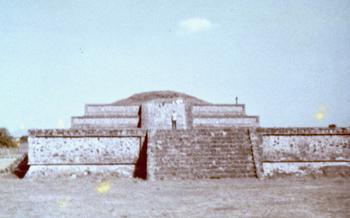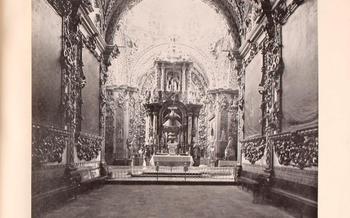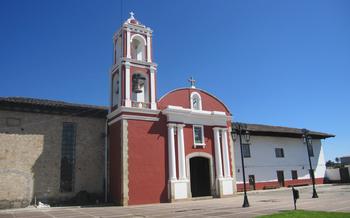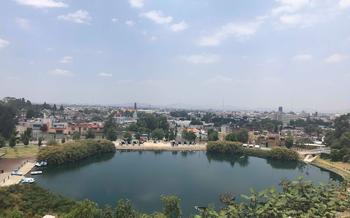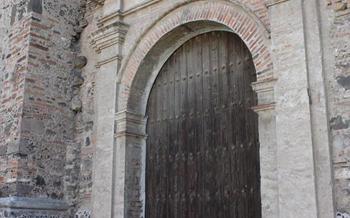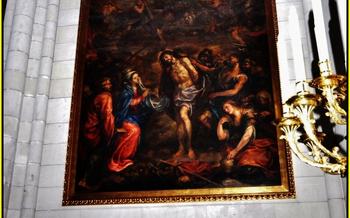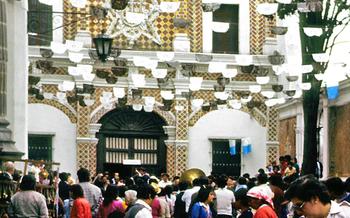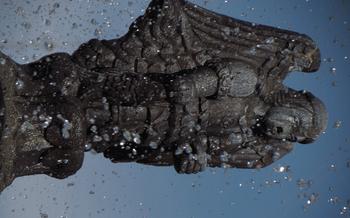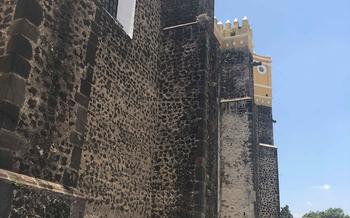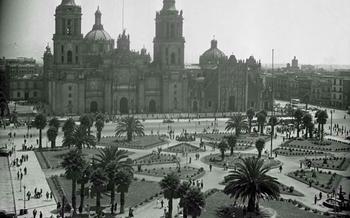
Catedral de Puebla (Puebla Cathedral)
- The Puebla Cathedral: An Architectural Masterpiece
- Admire the Majestic Facade of the Catedral de Puebla
- Step Inside the Grand Interior of the Puebla Cathedral
- Discover the Capilla del Rosario: A Hidden Gem
- Attend a Mass or Religious Service
- Explore the Surrounding Area: A Cultural Haven
- Uncover the Legends and Myths of the Cathedral
- Learn about the Role of the Puebla Cathedral in Mexican History
- Support Local Artisans: Shop for Souvenirs
- Indulge in Local Delicacies: Food and Drinks
- Insider Tip: Plan Your Visit Wisely
The Puebla Cathedral: An Architectural Masterpiece
In the heart of Puebla, Mexico, stands the Catedral de Puebla, an awe-inspiring architectural marvel that has captivated hearts for centuries. This magnificent edifice holds a prominent place in Mexican history, showcasing a blend of architectural styles that harmoniously coexist within its sacred walls. Its stunning interior, adorned with intricate artwork and impressive stained glass windows, exudes an atmosphere of grandeur and spirituality. As a symbol of religious devotion and cultural heritage, the Puebla Cathedral proudly stands as a testament to the city's rich past and vibrant present, inviting visitors to embark on a journey of discovery and wonder.
Admire the Majestic Facade of the Catedral de Puebla
The facade of the Catedral de Puebla is a testament to the grandeur and artistry of Baroque architecture. It features an intricate blend of Churrigueresque and Neoclassical elements, creating a visually stunning masterpiece. The facade is adorned with sculptures and reliefs depicting biblical scenes and religious figures, each intricately carved with exceptional detail. One of the most striking features is the use of Talavera tiles, a traditional Mexican ceramic, which adds vibrant colors and patterns to the facade. These tiles depict various scenes from the Bible and Mexican history, adding a unique touch to the cathedral's exterior. The main entrance is flanked by two bell towers, which soar high above the city skyline. The towers are adorned with decorative elements and topped with spires, adding a sense of verticality and grandeur to the overall composition.
Step Inside the Grand Interior of the Puebla Cathedral
Prepare to be awestruck as you step through the threshold of the Puebla Cathedral, where every inch of the interior exudes grandeur and devotion. The cathedral's expansive nave, with its soaring vaulted ceilings, creates a sense of awe and reverence. Gaze upon the intricate frescoes that adorn the walls and ceilings, depicting biblical scenes and the lives of saints. The artistry and vibrant colors of these murals will leave you spellbound.
Marvel at the impressive stained glass windows that bathe the interior in a kaleidoscope of hues. The intricate designs and vibrant colors of these windows tell stories from the Bible and the history of the Catholic Church. Each window is a masterpiece in its own right, casting a warm glow upon the faithful below.
Intricate carvings adorn the elaborate altars, which are adorned with gold leaf, precious stones, and religious iconography. Each altar is a testament to the skill and devotion of the artisans who created them. The main altar, dedicated to the Virgin Mary, is particularly impressive, with its intricate carvings and shimmering gold leaf.
Look out for unique architectural features, such as the choir stalls, which are intricately carved with scenes from the Bible. The pulpit, with its elegant design and intricate carvings, is another highlight of the cathedral's interior. These elements add to the overall grandeur and beauty of the space.
Discover the Capilla del Rosario: A Hidden Gem
Concealed within the of the Rosary). This exquisite Baroque chapel is a testament to the artistry and devotion that permeate this sacred space. Step inside to be captivated by the stunning gold-leaf decorations that adorn every surface, creating an atmosphere of opulent splendor. Masterpieces by renowned artists, including Cristóbal de Villalpando and José Juárez, grace the walls, showcasing the chapel's artistic significance.
As you explore the Capilla del Rosario, delve into its historical and religious significance. Originally constructed as a private chapel for the bishop of Puebla, it later became a site of worship for the city's elite. Today, it stands as a testament to the enduring faith and devotion of the Mexican people. Allow yourself to be transported back in time as you wander through this hidden gem, marveling at its intricate details and the stories it holds.
Attend a Mass or Religious Service
Immerse yourself in the spiritual grandeur of the Catedral de Puebla by attending a mass or religious service. Experience the devotion and tranquility that permeate the cathedral's hallowed halls as the local faithful gather for worship. Witness the elaborate rituals and ceremonies conducted by the clergy, accompanied by the melodious hymns of the choir. Attending a mass or service offers a unique perspective into the deep-rooted religious traditions of Puebla and provides an opportunity to connect with the local community on a deeper level.
Tips for Respectful Participation
- Dress modestly and appropriately, covering your shoulders and knees.
- Arrive early to secure a seat and avoid distractions during the service.
- Remain silent and refrain from talking or using electronic devices.
- Follow the lead of those around you in terms of standing, sitting, and kneeling.
- If you are unfamiliar with the Catholic liturgy, simply observe and enjoy the experience.
Explore the Surrounding Area: A Cultural Haven
The Catedral de Puebla is nestled in the heart of the city's historic center, a treasure trove of cultural and architectural wonders. Take advantage of your visit to explore the surrounding area and immerse yourself in Puebla's rich heritage.
Begin your exploration in the Zócalo, the main square of Puebla, where you'll find the majestic Palacio Municipal and the Portal de las Flores, a vibrant arcade filled with colorful shops and cafes. Stroll along the Calle de los Dulces, a street dedicated to traditional sweets and candies, where you can indulge your sweet tooth and discover local delicacies like camotes, borrachitos, and tortitas de Santa Clara.
Venture into the hidden plazas and courtyards that dot the city center, each with its own unique charm and history. Discover the serene beauty of the Plazuela de San Pedro, with its tranquil fountain and colonial-era buildings, or the vibrant atmosphere of the Mercado de El Parián, a lively market where you can find everything from traditional handicrafts to local produce.
Immerse yourself in Puebla's vibrant culture by visiting the numerous museums and galleries in the area. The Museo Amparo showcases a vast collection of pre-Hispanic and colonial art, while the Museo Casa del Alfeñique is a stunning example of Baroque architecture and houses a collection of decorative arts.
Puebla is also renowned for its vibrant culinary scene. Take the opportunity to sample local delicacies like mole poblano, chalupas, and cemitas at one of the many restaurants or street food stalls in the city center. Be sure to try the famous "tortita de Santa Clara," a sweet bun filled with candied fruit and nuts, a local specialty.
Uncover the Legends and Myths of the Cathedral
The Catedral de Puebla is steeped in a rich tapestry of legends and myths that have been passed down through generations. Locals whisper tales of miraculous interventions, ghostly apparitions, and hidden treasures buried beneath the cathedral's grand structure. One popular legend tells of a secret tunnel that connects the cathedral to a nearby convent, allowing priests to escape during times of danger. Another speaks of a hidden chamber beneath the altar, said to contain a vast collection of gold and jewels donated by wealthy patrons throughout the centuries. Whether these stories are fact or fiction, they add an aura of mystery and intrigue to the cathedral, captivating the imaginations of visitors and locals alike.
As you wander through the cathedral's hallowed halls, let your mind wander and embrace the magic of these legends. Feel the weight of history as you imagine the footsteps of ancient pilgrims and the whispered secrets of long-forgotten saints. The Catedral de Puebla is not just a religious monument; it is a living testament to the rich cultural heritage and vivid imagination of the Mexican people.
Learn about the Role of the Puebla Cathedral in Mexican History
The Catedral de Puebla has played a pivotal role in the history and cultural development of Mexico. As a symbol of faith and power, the cathedral has witnessed numerous historical events that have shaped the nation. During the colonial era, it served as the seat of the powerful Catholic Church and was a crucial center for religious and political gatherings. Throughout the years, it has been a place of refuge, celebration, and mourning, bearing witness to pivotal moments in Mexico's struggle for independence, the Reform War, and the Mexican Revolution.
The cathedral's cultural significance extends beyond its religious function. It has become an iconic landmark that represents the city of Puebla and the state of Puebla. Its unique architectural style, with its blend of Spanish, Italian, and indigenous influences, has made it a symbol of Mexican heritage and a source of national pride. The cathedral's interior is adorned with priceless artwork, sculptures, and paintings that showcase the artistic talents of renowned Mexican artists and reflect the country's rich cultural traditions.
Support Local Artisans: Shop for Souvenirs
When visiting the Catedral de Puebla, don't miss the opportunity to support local artisans by purchasing unique souvenirs. The city is renowned for its vibrant art scene and traditional crafts.
-
Talavera Pottery: Talavera pottery is a distinctive type of ceramic that originated in the city of Puebla. These colorful, hand-painted tiles and decorative items are highly sought after by collectors and make excellent souvenirs.
-
Traditional Crafts: Puebla is home to a variety of traditional crafts, including hand-woven textiles, leather goods, and silver jewelry. Stroll through the local markets or visit artisan workshops to find one-of-a-kind pieces that showcase the city's rich cultural heritage.
-
Local Markets: For a truly immersive experience, visit one of Puebla's many local markets. Here you'll find a treasure trove of souvenirs, from traditional crafts to delicious local delicacies. Be sure to haggle for the best prices and support the local economy.
-
Ethical Shopping Practices: When shopping for souvenirs, remember to be mindful of ethical practices. Support artisans who are fairly compensated for their work and avoid buying souvenirs made with unsustainable materials or processes.
Indulge in Local Delicacies: Food and Drinks
Puebla's culinary scene is a delightful blend of indigenous, Spanish, and international influences, offering a feast for the senses.
-
Traditional Dishes: Savor mouthwatering dishes such as mole poblano, a complex sauce made with over 20 ingredients and served with chicken or turkey, and chiles en nogada, a stuffed poblano pepper topped with a creamy walnut sauce and pomegranate seeds.
-
Street Food: Explore the vibrant street food stalls for a taste of local favorites like tacos al pastor, spit-roasted pork tacos, and tlayudas, large tortillas topped with beans, cheese, and meat.
-
Local Markets: Immerse yourself in the bustling atmosphere of local markets, where you can find fresh produce, traditional ingredients, and delicious street food.
-
Culinary Experiences: Participate in cooking classes to learn how to prepare traditional dishes, or embark on a food tour to discover hidden culinary gems and learn about Puebla's rich culinary history.
Insider Tip: Plan Your Visit Wisely
-
Avoid Crowds: The cathedral is a popular tourist destination, so it's best to plan your visit accordingly. Aim to arrive early in the morning or late in the afternoon to avoid the peak crowds.
-
Dress Appropriately: Remember that the cathedral is a sacred place of worship, so dress respectfully. Avoid shorts, tank tops, or revealing clothing.
-
Respect Local Customs: Be mindful of local customs and traditions. Refrain from talking loudly, taking photos during religious services, or disturbing worshippers.
-
Wheelchair Accessibility: The cathedral is wheelchair accessible, with ramps and elevators available for easy access.
